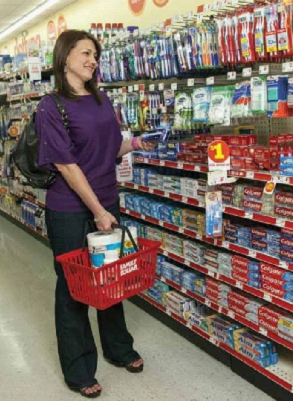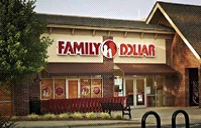Small Tag, Big Results
2014.01.17

With shoplifting and organized retail crime seemingly a fact of life in today’s environment, retailers attempt various methods to deter criminals from sweeping products off their shelves. Family Dollar recently deployed electronic article surveillance tags in a 200-store test and saw such positive results that the retailer is rolling out the system to all of its nearly 8,000 stores.
Checkpoint Systems’ EVOLVE P10 ECO article surveillance solution includes non-contact deactivation pads that integrate into Family Dollar’s point of sale system. Family Dollar has used EAS tags in its stores for 15 years, but vice president of loss prevention Chris Nielsen says it sought “one solution that would affect every store so we could simplify our team’s workload.”
Versatile formatFamily Dollar started looking for a more comprehensive EAS solution three years ago and began testing EVOLVE in July 2012. After evaluating the results of the eight-month pilot, Nielsen says Family Dollar concluded that shrink rates declined “significantly” while sales and in-stock rates improved.
Dan Reynolds, Checkpoint’s vice president for North American sales, says EVOLVE provides a host of intelligent features, like data analytics, smart alarm management and people counting software, that can be added to the EVOLVE pedestal antennas.
One of the biggest advantages for Family Dollar, says Nielsen, is that the soft tags can be applied to a wide variety of products. Because the tags can be as small as a half-inch square, they can go on small, high-price, high-shrinkage health and beauty care items — a product assortment that Family Dollar has expanded in its newer format stores.
Just as important, the tags can be applied with the Family Dollar store brand visibly displayed. Nielsen says that feature helps “significantly discourage” ORC thieves.
“Organized retail criminals know that it’s harder to sell stolen items if a store has its brand on them,” he says. “And to remove the tag and our brand, to rip them off, they have to deface the products. [This] reduces their value because potential customers, whether flea markets or individuals, then know the items have been stolen and they won’t buy them.”
Having its store brand on the tags has also made it easier for Family Dollar to recover stolen merchandise “when police have apprehended folks targeting our stores,” Nielsen says.
Reynolds says putting a store brand on the EAS tag “has proven to lower shrink and increase sales even more than traditional EAS tags without a store brand.”
Improved in-stock ratesThe retail price was not the primary factor in determining which items got tagged in Family Dollar’s test: The shrink rate was the most important metric, so Family Dollar put the tags on its 500 most frequently stolen items.
“If a $3 deodorant has a 15 percent shrink rate, that item will be tagged while a higher price point item with a much lower shrink rate might not be tagged,” Nielsen says.
Management took a complete inventory count both before and after the test, shortening its inventory period from 12 months to six or nine months for the test. “It was the only way we knew we could feel comfortable with the test results,” Nielsen says. “We measured very carefully. We saw external theft decrease significantly and our in-stock rates and sales improved considerably.”
Store-level employees currently attach the tags to high-risk items, but as the system is deployed to larger numbers of stores Family Dollar will implement a source tagging program designed to encourage its vendors to apply the tags at their manufacturing or distribution sites.
For vendors that don’t have a source tagging initiative, Nielsen says the tags will be applied at a Family Dollar distribution center so store employees can “spend more time helping customers. Our ultimate goal is to make the stores easier to operate.
“We hope to have the source tagging supplier initiative in place within a year.”
Turnkey systemThe system was “seamless” to deploy, Nielsen says. “It was not challenging at all. It was easy. It was just working with Checkpoint and the logistics from their perspective.”
Checkpoint, which has extensive experience rolling EVOLVE merchandise availability solutions out to large chains, offers a comprehensive turnkey program managed by their national field service team.
In a typical Family Dollar store, Reynolds says, “if everything goes well, we can do a full store installation in about four hours.”
Checkpoint worked closely with Family Dollar to determine the best strategic way to manage the deployment. It also helped Family Dollar develop the training for the store associates who will be tagging the most at-risk items and scanning them at the checkout. Checkpoint EVOLVE deactivation pads mean employees don’t have to spend additional time removing the labels.
Checkpoint’s EVOLVE ECO solution also reduces energy costs. It uses “the lowest amount of electricity required, which generates those savings,” Reynolds says. “Costs, on average, can be reduced 60 to 75 percent compared to other EAS technologies.”

‘More benefit’Nielsen says that Family Dollar store employees love the system.
“Our store managers are very shrink conscious and they’re trying to drive sales,” he says. “They see the value in a tool that helps them be successful. They feel like the organization is helping them be successful in their stores.”
As EVOLVE rolls out to more stores, Nielsen is confident that “we will see more benefit as an organization.
“We analyzed the ROI after the test results, and, based on our analysis, there was a very compelling case to install EVOLVE chainwide, and that’s why we’re going forward with the solution.”
On average, Reynolds says, retailers not already using EAS in stores generally receive “a very strong payback in anywhere from six to nine months, mostly from reduced shrink but also because of the corresponding increases in in-stock rates and sales.
“Every retailer looks at shrink differently,” he says, “but with that kind of payback, they are going to see a 30 percent or more shrink reduction overall in the store.”
Nielsen says that Family Dollar believes that EVOLVE “is going to help us drive down shrink, increase sales and help with store simplification initiatives, making our store managers’ jobs easier and improving the customer service experience.”

















 Visitor Registration
Visitor Registration Booth Application
Booth Application